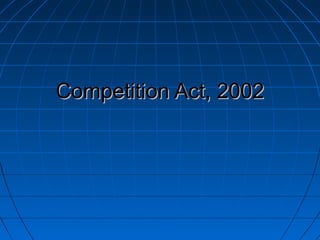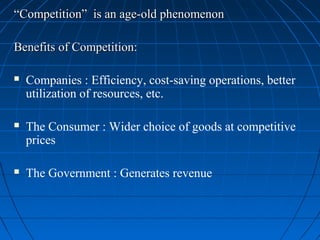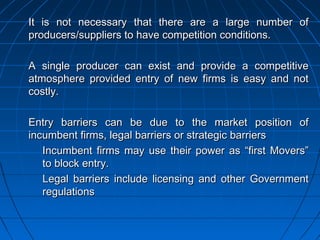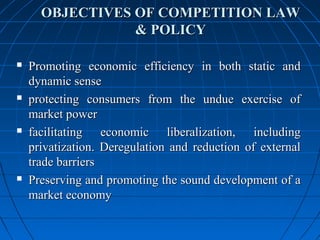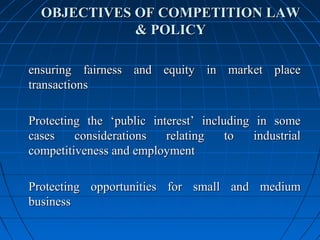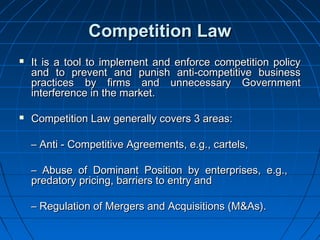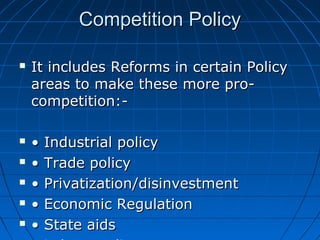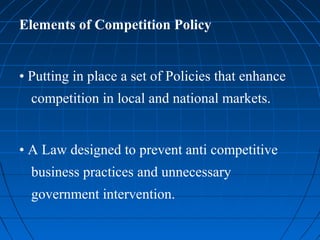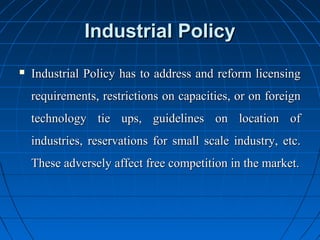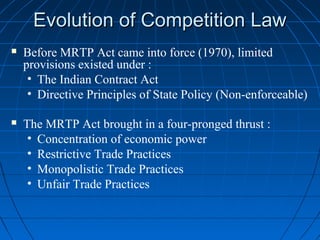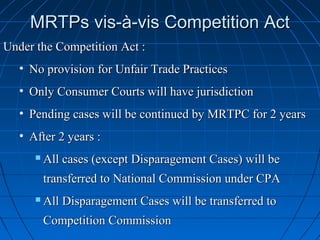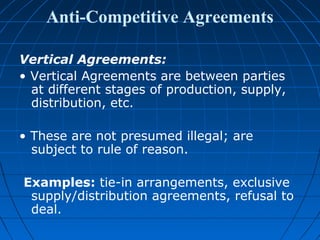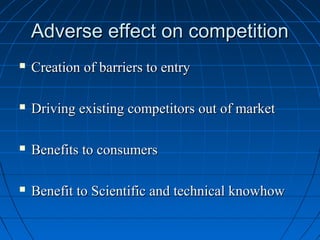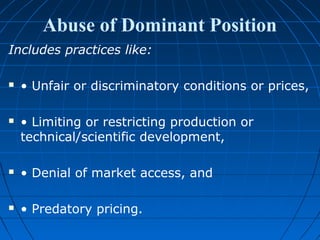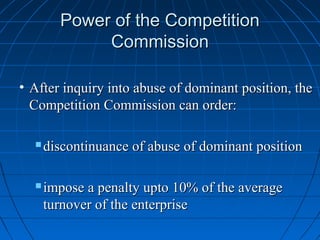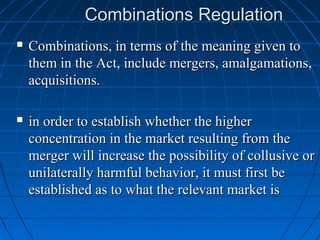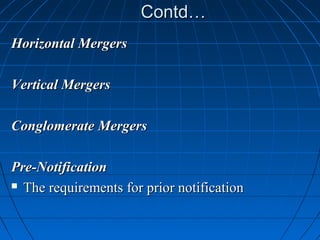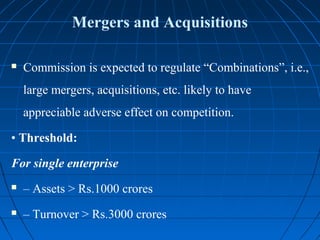Competitionact2002 090902133438-phpapp01
- 2. ïŪ Competition Is âa situation in a market in which firms or sellers independently strive for the buyersâ patronage in order to achieve a particular business objective for example, profits, sales or market shareâ (World Bank, 1999)
- 3. âCompetitionâ is an age-old phenomenon Benefits of Competition: ïŪ Companies : Efficiency, cost-saving operations, better utilization of resources, etc. ïŪ The Consumer : Wider choice of goods at competitive prices ïŪ The Government : Generates revenue
- 4. It is not necessary that there are a large number of producers/suppliers to have competition conditions. A single producer can exist and provide a competitive atmosphere provided entry of new firms is easy and not costly. Entry barriers can be due to the market position of incumbent firms, legal barriers or strategic barriers Incumbent firms may use their power as âfirst Moversâ to block entry. Legal barriers include licensing and other Government regulations
- 5. OBJECTIVES OF COMPETITION LAW & POLICY ïŪ Promoting economic efficiency in both static and dynamic sense ïŪ protecting consumers from the undue exercise of market power ïŪ facilitating economic liberalization, including privatization. Deregulation and reduction of external trade barriers ïŪ Preserving and promoting the sound development of a market economy
- 6. OBJECTIVES OF COMPETITION LAW & POLICY ensuring fairness and equity in market place transactions Protecting the âpublic interestâ including in some cases considerations relating to industrial competitiveness and employment Protecting opportunities for small and medium business
- 7. Competition Law ïŪ It is a tool to implement and enforce competition policy and to prevent and punish anti-competitive business practices by firms and unnecessary Government interference in the market. ïŪ Competition Law generally covers 3 areas: â Anti - Competitive Agreements, e.g., cartels, â Abuse of Dominant Position by enterprises, e.g., predatory pricing, barriers to entry and â Regulation of Mergers and Acquisitions (M&As).
- 8. ContdâĶ The need for Competition Law arises because market can suffer from failures and distortions, and various players can resort to anti-competitive activities such as cartels, abuse of dominance etc. which adversely impact economic efficiency and consumer welfare. Thus there is need for Competition Law, and a Competition Watchdog with the authority for enforcing Competition Law.
- 9. Competition Policy ïŪ It includes Reforms in certain Policy areas to make these more pro- competition:- ïŪ âĒ Industrial policy ïŪ âĒ Trade policy ïŪ âĒ Privatization/disinvestment ïŪ âĒ Economic Regulation ïŪ âĒ State aids
- 10. Elements of Competition Policy âĒ Putting in place a set of Policies that enhance competition in local and national markets. âĒ A Law designed to prevent anti competitive business practices and unnecessary government intervention.
- 11. Industrial Policy ïŪ Industrial Policy has to address and reform licensing requirements, restrictions on capacities, or on foreign technology tie ups, guidelines on location of industries, reservations for small scale industry, etc. These adversely affect free competition in the market.
- 12. Trade Policy ïŪ Trade policy has important implications for development of competition in the markets. Measures for liberalisation of trade promote greater competition e.g. reducing tariffs, removal of quotas/physical controls, investment controls, conditions relating to local content etc.
- 13. Economic Regulations ïŪ New legislation and regulations to promote competition and to bring about restructuring of major industrial sectors is essential. Legislation to aim at separating natural monopoly elements from potentially competitive activities, and the regulatory functions from commercial functions, and also create several competing entities through restructuring of essential competition activities and to create a competitive environment . ïŪ Examples: â Electricity sector â Telecommunications sector â Ports
- 14. Evolution of Competition Law ïŪ Before MRTP Act came into force (1970), limited provisions existed under : âĒ The Indian Contract Act âĒ Directive Principles of State Policy (Non-enforceable) ïŪ The MRTP Act brought in a four-pronged thrust : âĒ Concentration of economic power âĒ Restrictive Trade Practices âĒ Monopolistic Trade Practices âĒ Unfair Trade Practices
- 15. MRTPs vis-Ã -vis Competition Act Under the Competition Act : âĒ No provision for Unfair Trade Practices âĒ Only Consumer Courts will have jurisdiction âĒ Pending cases will be continued by MRTPC for 2 years âĒ After 2 years : ïŪ All cases (except Disparagement Cases) will be transferred to National Commission under CPA ïŪ All Disparagement Cases will be transferred to Competition Commission
- 16. Status of the Competition Commission âĒ It is a body corporate âĒ It has Regulatory and quasi-judicial powers; functions through Benches âĒ Each Bench shall consist of at least two Members and one of such Members must be a judicial Member
- 17. Agreement ïŪ Any arrangement or understanding or action in concert â Whether or not such arrangement or understanding is formal or in writing Or whether or not such understanding or arrangement is intended to be enforceable by legal proceedings
- 18. Anti-competitive Agreements These are agreements which cause or are likely to cause an appreciable adverse effect on competition within India: ïŪ Horizontal Agreements: These are between and among competitors who are at the same stage of production, supply, distribution, etc. These are presumed to be illegal Examples: cartels, bid rigging, collusive bidding, sharing of markets, etc.
- 19. Anti-Competitive Agreements Vertical Agreements: âĒ Vertical Agreements are between parties at different stages of production, supply, distribution, etc. âĒ These are not presumed illegal; are subject to rule of reason. Examples: tie-in arrangements, exclusive supply/distribution agreements, refusal to deal.
- 20. Adverse effect on competition ïŪ Creation of barriers to entry ïŪ Driving existing competitors out of market ïŪ Benefits to consumers ïŪ Benefit to Scientific and technical knowhow
- 21. CCI orders against Anti-competitive agreements ïŪ Penalty equal to three times the amount of profit made out of such agreement or 10% of average turnover of the cartel for preceding three years whichever is higher ïŪ Modification directed to the agreement
- 22. Powers of Competition Commission as Regards Agreements ïŪ After the inquiry into the Agreement, Competition Commission can: âĒ direct parties to discontinue the agreement âĒ prohibit parties from re-entering such agreement âĒ direct modification of the agreement âĒ impose penalty upto 10% of average turnover of the enterprise
- 23. Abuse of Dominance ïŪ âDominant positionâ is defined as a position of strength which enables the enterprise âĒ to operate independently of competitive forces in the market, or âĒ to affect its competitors or consumers in its favor. ïŪ No mathematical or statistical formula is adopted to âmeasureâ dominance â
- 24. Abuse of Dominant Position Includes practices like: ïŪ âĒ Unfair or discriminatory conditions or prices, ïŪ âĒ Limiting or restricting production or technical/scientific development, ïŪ âĒ Denial of market access, and ïŪ âĒ Predatory pricing.
- 25. Power of the Competition Commission âĒ After inquiry into abuse of dominant position, the Competition Commission can order: ïŪ discontinuance of abuse of dominant position ïŪ impose a penalty upto 10% of the average turnover of the enterprise
- 26. Combinations Regulation ïŪ Combinations, in terms of the meaning given to them in the Act, include mergers, amalgamations, acquisitions. ïŪ in order to establish whether the higher concentration in the market resulting from the merger will increase the possibility of collusive or unilaterally harmful behavior, it must first be established as to what the relevant market is
- 27. ContdâĶ Horizontal Mergers Vertical Mergers Conglomerate Mergers Pre-Notification ïŪ The requirements for prior notification
- 28. Mergers and Acquisitions ïŪ Commission is expected to regulate âCombinationsâ, i.e., large mergers, acquisitions, etc. likely to have appreciable adverse effect on competition. âĒ Threshold: For single enterprise ïŪ â Assets > Rs.1000 crores ïŪ â Turnover > Rs.3000 crores
- 29. Mergers and Acquisitions Threshold: For group of enterprises ïŪ â Assets > Rs.4000 crores ïŪ â Turnover > Rs.12000 crores Similarly, threshold is provided for overseas groups.
- 30. Mergers & Acquisitions âĒ Notification of Combination to Commission is voluntary ïŪ âĒ If notified, Commission to take a decision within 90 days on the combination. Decision may allow, disallow, modify, etc. the combination.

